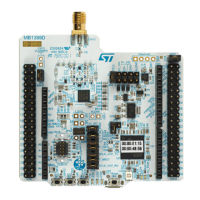RM0453 Rev 1 99/1461
RM0453 Embedded Flash memory (FLASH)
153
boot from. It prevents the system to boot from the Flash main memory area when, for
example, no user code is programmed.
The Flash main memory empty check status can be read from the EMPTY bit in the
FLASH_ACR register. Software can modify the Flash main memory empty status by writing
to the EMPTY bit.
4.3.3 Error code correction (ECC)
Data in Flash memory words are 72-bit wide: eight bits are added per each double-word
(64 bits).
The ECC mechanism supports the following modes:
• one error detection and correction
• two errors detection
When one error is detected and corrected, the flag ECCC (ECC correction) is set in
FLASH_ECCR. If ECCCIE is set, an interrupt is generated.
When two errors are detected, the flag ECCD (ECC detection) is set in FLASH_ECCR. In
this case, an NMI is generated.
When an ECC error is detected, the address of the failing double-word is saved in
ADDR_ECC[16:0] in FLASH_ECCR. ADDR_ECC[2:0] bits are always cleared. The bus-ID
of the CPU accessing the address is saved in CPUID[2:0].
While ECCC or ECCD is set, FLASH_ECCR is not updated if a new ECC error occurs.
FLASH_ECCR is updated only when ECC flags are cleared.
Note: For a virgin data (0xFF FFFF FFFF FFFF FFFF), one error is detected and corrected, but
the two errors detection mode is not supported.
When an ECC error is reported, a new read at the failing address may not generate an ECC
error if the data is still present in the current buffer, even if ECCC and ECCD are cleared. If
this is not the desired behavior, the user must reset the cache.
4.3.4 Read access latency
To correctly read data from the Flash memory, the number of wait states (LATENCY[2:0])
must be correctly programmed in FLASH_ACR according to the frequency of the Flash
memory clock (HCLK3) and the internal voltage range of the device (V
CORE
). Refer to
Section 6.1.4: Dynamic voltage scaling management.
The table below shows the correspondence between wait states and frequency of the Flash
memory clock.
Table 12. Number of wait states according to Flash clock (HCLK3) frequency
Wait states (WS)
(access)
HCLK3 (MHz)
V
CORE
range 1 V
CORE
range 2
0 WS (1 HCLK cycle) ≤ 18 ≤ 6
1 WS (2 HCLK cycles) ≤ 36 ≤ 12
2 WS (3 HCLK cycles) ≤ 48 ≤ 16

